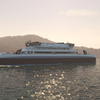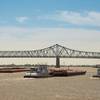Emergency Beacon, Preparedness Save Mariner Off Diamond Head
The Coast Guard rescued a man in a life raft after his sailboat sank approximately seven miles south of Diamond Head, Tuesday.
Watchstanders at the Coast Guard Sector Honolulu command center overheard a brief mayday call over VHF channel 16 at 7:43 p.m., with no additional information.
Sector Honolulu received a call from a woman at 9:05 p.m., stating her friend had gone out sailing Tuesday evening in his 41-foot sailing vessel, Esperanza, and had not returned. She also stated that her friend had sent her a text message saying he needed help, provided his position and to "Send the Coast Guard."
Sector Honolulu diverted a 45-foot Response Boat-Medium boat crew at 9:16 p.m., from Coast Guard Station Honolulu to begin a search.
At 9:44 p.m., the RB-M crew noticed a blinking light in the vicinity of the relayed position and discovered a mariner in a small life raft holding an activated and blinking Emergency Position Indicating Radio Beacon and GPS tracker.
The Coast Guard received the first located signal from the EPIRB at 9:26 p.m. At 9:50 p.m., the exact location of the EPIRB was received.
The man stated his boat had struck something very hard, began taking on water and rapidly sank. He had just enough time to transmit a brief distress call on the radio, message his friend, deploy his life raft and activate his EPIRB.
The man was safely transported to Coast Guard Base Honolulu where his friend picked him up. No injuries were reported. The boat sank in approximately 300 feet of water.
"The man seemed to be very well prepared with the proper lifesaving equipment," said Petty Officer 1st Class Tyler Peterson, a watchstander at Sector Honolulu. "If it wasn't for his EPIRB and text message being sent, we would have been searching in the wrong area."
Maritime accidents can occur quickly and without warning to even the most experienced mariners. The Coast Guard advises all mariners to ensure they have a working VHF radio, flares, lifejackets and an EPIRB. Multiple communications mechanisms, such as VHF radios, an EPIRB and flares, greatly improve the chance of signaling distress. Mariners are also advised to file a float plan with a friend, family member or local harbormaster. Float plans provide critical information to first responders should a mariner fail to return, such as in this case.
For more information about EPIRB's, visit the Official Blog of the U.S. Coast Guard: 'What's an EPRB?' For a complete list of recommended safety equipment visit www.uscgboating.org.










